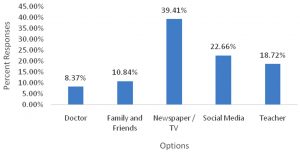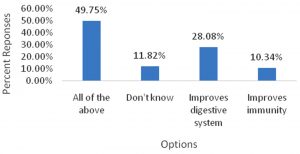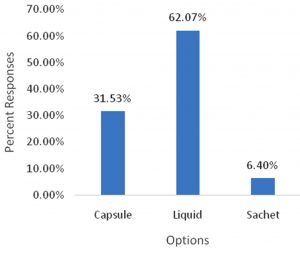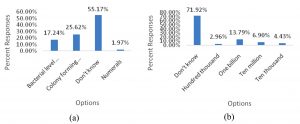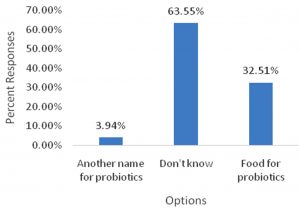ISSN: 0973-7510
E-ISSN: 2581-690X
Probiotics are important for maintaining good gut health. In the present scenario when drug resistance among pathogenic bacteria is increasing, it has become of utmost importance for everyone to keep healthy gut microbiome. Therefore the topic of probiotics has relevance to each and everyone of us. With this view in mind, a survey was conducted among college students and few other professionals to gather information regarding its awareness. Since majority respondents were students, an analysis was done amongst student subcategory only. A questionnaire was developed which had variety of questions comprising general awareness about the term probiotic products available, technical know how and sources from where to obtain them. In this respect the term prebiotics was also put forth as general commercial compositions mention both prebiotic and probiotics. The data was analysed using Microsoft Excel and SPSS software. Overall the survey indicated that students were well aware of the meaning of the term probiotics. Majority have learnt it from newspaper or TV, however they did not know technical specifications necessary when purchasing nor were they familiar with the trade names of probiotic preparations available in market. Further, students knew that food and supplements are sources for probiotics but were not familiar with the term prebiotic.
Prebiotics, Probiotics, Students, Survey.
With an increase in awareness about health among the public and a desire for access to unfiltered, simple healthcare, a surge of interest has been observed in probiotic products over the 21st century. Probiotics are “live microorganisms which when administered in adequate amounts confer a health benefit on the host”, as defined by the World Health Organization. They are basically beneficial bacteria which, taken in an appropriate dosage are deemed beneficial for a vast spectrum of diseases like Irritable Bowel Syndrome, diarrhoeal diseases including infantile, traveller’s and antibiotic associated diarrhoea, lactose intolerance, allergic diseases, bladder, colon cancer and in strengthening of intestinal immunity. In addition to this, probiotics have also been reported to reduce total serum cholesterol1. Recent studies have documented the beneficial role of probiotics for the prevention and treatment of antibiotic-associated diarrhoea, lactose intolerance and allergy2. A special class of probiotics ie. psychobiotics have been conferred to provide mental health benefits to patients with psychiatric or neurological illness3.
Although the advantages of ingesting bacterial fermented food products have been known to man for centuries, the idea of administering specific microorganisms through diet in order to improve gut health began when a theory called the “Theory of Longevity” proposed by Metchnikoff claimed that health could be enhanced, along with delaying ageing, by changing the already present intestinal microbiota with beneficial bacteria found in yoghurt4.
It is important to emphasize that only those bacterial strains that are fully characterized can be categorized a probiotic5. The most common probiotic microorganisms belong to the genera Lactobacillus, Bifidobacterium, Enterococcus, Streptococcus, and Escherichia to name a few. It is also important to note that the effects of probiotics are strain specific and they may be able to provide unique benefits. In addition, the successful performance of one strain cannot be extrapolated to another strain6. Strain identification can be done by utilizing novel molecular based technologies like pulsed field gel electrophoresis and randomly amplified polymorphic DNA and analysing phenotypic traits like checking for the presence of extrachromosomal genetic elements, fermentation of selective sugars and detection of final fermentation products after glucose utilization7.
The advantages conferred by the probiotics are attributed to their ability to maintain a good balance of the intestinal flora composition8. The precarious balance if disturbed, can lead to several health disorders. Hence, when probiotics are ingested, they correct the state of dysbiosis of the gut to restore the normal microbiota population proportion.
An ideal probiotic preparation is considered to be the one that has high cell viability, i.e. is resistant to low pH and acids, ability to persist in the intestine even if the probiotic strain cannot colonize the gut, adhesion to the gut epithelium, ability to interact and send signals to the immune cells associated with the gut, ability to influence local metabolic activity, resistant to processing and is non- pathogenic in nature9.
In addition to probiotics, prebiotics also play a vital role for maintaining healthy gut environment. Prebiotics are non-digestible food ingredients that act as food for probiotic bacteria. By including a variety of foods in their diet, people can ensure that they consume a range of prebiotics that will in turn feed various probiotic bacteria10. Prebiotics like inulin and pectin show various health benefits like declining the frequency and duration of diarrhoea, relief from inflammation and symptoms of intestinal bowel disorder and prevention of colon cancer11. They have also been claimed to enhance the bioavailability and uptake of minerals, decrease risk factors of cardiovascular disease, and preventing obesity12.
Probiotics and prebiotics are available in a myriad of forms commercially in the market such as functional food and beverages (dairy products, non-dairy beverages, breakfast cereal, baked foods, fermented meat products, dry-food probiotics), dietary supplements (food supplements and nutritional supplements), speciality nutrients (infant formulation), pharmaceutical preparations and as animal feed13.
Since the knowledge of the relationship between diet and health has increased significantly in recent years, with consumers now looking for ways that have a direct action on health, the market platform for probiotic products is flourishing. This fact has also been reinforced by the large number of clinical research trials that provide a growing evidence of its potential benefits to the consumer.
Although the average person recognizes the advantages conferred by probiotics and hence the increase in the demand, many consumers lack the knowledge of nuances required to identify and buy these probiotic foods. Many more still are not aware of its existence. This lack of knowledge of probiotics among the people and generally poor awareness of their beneficial effects result in either under consumption or the intake of wrong type of probiotic or in wrong doses, wherein they may not act as desired.
There are not many studies that shed light on probiotics from a consumer’s perspective; their perception, beliefs and knowledge. Therefore, the objective of the current study is to comprehend and assess the extent of awareness about probiotics among college students and determine the factors, if any present, that might influence probiotic consumption.
We conducted an observational study using online version of self administered questionnaire. The questionnaire was developed based on thorough review of relevant literature. It consisted of a total of 19 questions. The first part of the questionnaire consisted of socio-demographic data including age, gender, education and occupation. The second part aimed to explore the basic knowledge regarding probiotics (definitions, health benefits, sources etc.). The third part enquired about the technical details about commercial probiotic preparations (tradenames, bacterial counts etc). Last part of the questionnaire enquired about awareness about prebiotics.
For data collection, link of the google form containing the questionnaire was shared. Respondents filled it anonymously. They were asked to fill it only once. Further, the data was analyzed by Microsoft Excel and SPSS software.
The survey was filled by a total of 309 people, out of which 203 were college students of Delhi University, India. The other proportion of people who answered the questionnaire included 26 engineers, 23 teachers, 22 self-employed persons and others (Fig. 1). As the majority of survey respondents were students, further analysis was done amongst student’s data only.
With the increase in advertising and marketing of probiotic products in the 21st century, and more people becoming aware of gut health, the demand for probiotics is growing more and more. As a consequence, a whopping 91.6% people had heard about probiotics. Most of the students (39.41%) had become aware of existence of probiotics through the ever-ongoing advertisements on the television or newspaper. 22.66% people had heard about it on social media, through online forums and internet advertisements (Fig. 2).
Although, a major chunk of survey-takers had heard about probiotics through diverse platforms, some of them did not know what they actually meant. As discussed previously, probiotics are healthy bacteria that benefit the gastrointestinal tract and immune system. 88.70% of participants had the knowledge of what essentially constitutes a probiotic, but 3.49% thought it was a drug and a small fraction thought it to be a vitamin.
Upon being asked the benefits of these drinks, 10.34% thought it helped in building immunity, 28.08% people felt they improved the digestive system, which is generally what probiotics are tend to be associated with in TV commercials, while a good 49.75% respondents agreed with both the statements. The rest did not seem to have any idea about its advantages (Fig. 3).
Nowadays, doctors in most countries prescribe probiotics along with antibiotics. An antibiotic dosage not only kills the harmful pathogenic bacteria, it also tends to destroy the good bacteria in the gut creating an imbalance. This is often termed as ‘dysbiosis’ and it may lead to various gastrointestinal problems like diarrhoea. Probiotics generally help to restore that healthy balance. But only 19.21% people knew about any probiotics that their doctor prescribed. A total of 28.57% people claimed their doctors did not provide them with any probiotic supplements with antibiotics, while a major portion of participants i.e. 52.22% did not have any idea if their doctor prescribed probiotics or not, and whether any of the pills prescribed were probiotic in nature that they did not know of.
Probiotic supplements are available in most drug stores and supermarkets in numerous forms. They come as capsules or tablets to swallow, loose powder to sprinkle on food, or as drinks or in fermented and non-fermented dairy products14. Since a number of probiotics available in the market are in the form of drinks, they have higher popularity as the mode of consumption in the masses. People who regularly consumed probiotics, also felt that the liquid form was much easier to consume, as confirmed by 62.07% respondents. On the other hand, 31.53% found capsules to be much better, while the rest preferred sachet as a means of intake (Fig. 4).
Probiotics can be found in not only supplements, but also naturally in a variety of food products like yoghurt, kefir, tempeh, sauerkraut, miso, some varieties of cheese, kombucha, buttermilk etc. Upon analyzing the survey, it was found that majority of students were aware that probiotics can be consumed through food also in addition to external supplements.
According to an article by Hrefna Palsdottir, yoghurt is one of the best sources of probiotics, since it is made from milk that has been fermented by friendly bacteria, mainly lactic acid bacteria and Bifidobacteria15. In children, yoghurt may help reduce the diarrhoea caused by antibiotics. It can even help relieve the symptoms of irritable bowel syndrome (IBS). When asked if the survey audience ingested yoghurt because of the presence of probiotics, a big portion of 60.10% people answered with a yes, showing that they are well informed with the natural sources of probiotics.
It was further observed that although students were well acquainted with the basic knowledge about probiotics, the technical know how about the same was lacking. Majority of them (74.38%) were unaware about the tradenames of probiotic supplements available in the market. Another major group of around 72% did not know about unit of measurement and the recommended count of probiotic bacteria on the commercial labels (Fig. 5 a&b). A dosage of 108 CFU/day is recommended for ingestion, although there isn’t a specified level of probiotic bacteria in foods that would guarantee the biological activity. According to an article by Healthline, supplements that have live cultures, (i.e. consumption before expiration), multiple bacteria strains(a combination of probiotics is usually more effective than a single one) and appropriate quantities of bacteria to form colonies (measured in colony-forming units called CFUs) are the most effective16.
Fig. 5. Technical knowledge related to probiotic preparations
(a) Measurement of bacteria on probiotic preparation labels
(b) Number of probiotic bacteria that should be consumed each time
This extended knowledge about the details of probiotic supplements should also be disseminated as benefits of probiotic bacteria vary from strain to strain and for maximal health benefits, they should be consumed in the recommended doses.
In addition to this, the concept of prebiotics was majorly lacking amongst the students with only 32.5% of them knowing that prebiotics serve as food for optimal growth of probiotic bacteria (Fig. 6). It is suggested that the information regarding prebiotics should also be emphasized upon in the masses as prebiotics are fibres and natural sugars that stimulate the growth of good gut bacteria. They are included in various foods such as almonds, onion, garlic, certain fruits, cereal grains etc. These if included in day to day diet will help maintain a healthy gut environment for commensal gut flora as well as probiotic bacteria to grow. Additionally, prebiotic substances like indigestible carbohydrates, such as fructooligosaccharides and inulin have also been incorporated in a number of products like cheese and yoghurt, to maintain and enhance probiotic viability17. Thus, knowledge about prebiotics should not be neglected.
The expansion in the probiotic market indicates the rising interest of the public in gut health and their preference of natural remedies over allopathic medicine. According to our research, the general population of students seem to have good awareness and knowledge of probiotics albeit obtained from different sources.In accordance with a 2018 research survey done by Kolady et al. the respondents of the current study exhibited a high level of familiarityamong the students about probiotics18. Additionally, a greater level of knowledge was observed in the current study compared to a previous similar study conducted on college students in Phillippines by Meijia et al.where they had a good level of knowledge about probiotics and its consumption19.
Upon comparing it with a study performed on healthcare professionals in Nigeria, it was found 72.14% had heard of the term20. This was a drastic decline to the present 91.4% statistical data. This may have been due to higher exposure of the students to the concept of probiotics as a part of their educational curriculum or general classroom discussions. A similar trend was observed in a survey done on medical students, performed by Payahoo et al. wherein only 50.7% people had high knowledge21.
The survey-takers had a superficial knowledge of what probiotics essentially meant, referring to the good bacteria present in it and their contribution to health, but lacked critical information with respect to dosage and brand names. Most of them could associate with Yakult within the category, but failed to recognise other trade names.The basic technical knowledge prerequisite for proper consumption was missing,like the CFU count, prescription with antibiotics and the concept of prebiotics. In addition to this,they could identify that food and supplements both could contain probiotic gut bacteria, especially yoghurt, which was the reason for consumption for many respondents.
In a study by Stanczak and Heuberger published in 2009, participants when asked about the reason for consuming probiotics chose the option ‘increase immune function22, while in another study by Reshma et al.in 2017, 83.5% of the respondents selected the option which related to improvement of the gastrointestinal condition23. However, in the current study, although some people selected gastrointestinal or immune health as a benefit, a larger percentage (49.75%) picked both the options, inferring to a rise in knowledge of the advantages of probiotics among the people in the recent decade.
One more survey done on general dental practitioners exposed that around 22% of the respondents did not know about probiotics24. This came in accordance with another study by Betz et al, who found that younger survey-takerswho had higher education level were more likely to be familiar with the concept than with less education25. But on the other hand, in contrast to this was the study conducted in Jordan that revealed that college students lacked the important information about probiotics26. Merely 11.7% of students had a little level of knowledge about probiotics and unfortunately only a minute fraction-7.0% were capable to recognize probiotics.
We conducted a questionnaire-based survey regarding probiotics, which was successfully filled by 203 college students of Delhi. Overall analysis of the survey revealed that majority of the students were well aware about probiotics and their health benefits mainly through advertisements in newspapers and TV commercials. However, the technical information regarding the commercial probiotic products was lacking. Further, very few students were aware about prebiotics, which act as food for gut microbiome to flourish.
ACKNOWLEDGMENTS
The authors would like to thank the management of Shaheed Rajguru College of Applied Science for Women and Ram Lal Anand College, University of Delhi, for providing facilities for carrying out the present study.
CONFLICT OF INTEREST
The authors declare that there is no conflict of interest.
AUTHORS’ CONTRIBUTION
RS and SG conceptualized the present study and developed the questionnaire. DG and PKK contributed in performing the survey. SG and PKK performed the data interpretation. RS and DG compiled the information from the results and literature and drafted the manuscript. All authors read and approved the manuscript.
FUNDING
None.
ETHICS STATEMENT
Not Applicable as no personal details were asked by the participants and the survey was anonymous.
AVAILABILITY OF DATA
All datasets generated or analyzed during the study are included in the manuscript or Supplementary data files.
- Nguyen T D, Kang J H, Lee M S. Characterization of Lactobacillus plantarum PH04, a potential probiotic bacterium with cholesterol lowering effects. International Journal of Food Microbiology, 2007; 113(3): 358-361.
Crossref - Kechagia M, Basoulis D, Konstantopoulou S, Dimitriadi D, Gyftopoulou K, Skarmoutsou N, Fakiri EM. Health benefits of probiotics: a review. ISRN Nutr., 2013; 481651.
Crossref - Sarkar A, Lehto S M, Harty S, Dinan T G, Cryan J F, Burnet P W J. Psychobiotics and the Manipulation of Bacteria-Gut-Brain Signals. Trends Neurosci., 2016; 39(11): 763–781.
Crossref - Mackowiak PA. Recycling metchnikoff: probiotics, the intestinal microbiome and the quest for long life. Front Public Health, 2013; 1: 52.
Crossref - Bonifait L, Chandad F, Grenier D. Probiotics for oral health: Myth or reality? J. Can. Dent. Assoc., 2009; 75: 585–90.
- Azas-Braesco V, Bresson J L, Guarner F, Corthier G. Not all lactic acid bacteria are probiotics, … but some are. Br. J. Nutr., 2010; 103: 1079–1081.
Crossref - Food and Agriculture Organization of the United Nations/World Health Organization FAO/WHO. Guidelines for the Evaluation of Probiotics in Food. Joint FAO/WHO Working Group on Drafting Guidelines for the Evaluation of Probiotics in Food; London, Ontario, Canada: 2002.
- Markowiak P, Slizewska K. Effects of Probiotics, Prebiotics, and Synbiotics on Human Health. Nutrients, 2017; 9(9): 1021.
Crossref - Gupta V, Garg R. Probiotics. Indian Journal of Medical Microbiology. 2009; 27: 202–9.
Crossref - Davani-Davari D, Negahdaripour M, Karimzadeh I, Seifan M, Mohkam M, Masoumi S J, Berenjian A, Ghasemi Y. Prebiotics: Definition, Types, Sources, Mechanisms, and Clinical Applications. Foods, 2019; 8(3):92.
Crossref - Pena AS. Intestinal flora, probiotics, prebiotics, synbiotics and novel foods. Rev. Esp. Enferm. Dig., 2007; 99(11): 653.
Crossref - Pokusaeva K, Fitzgerald GF, van Sinderen D. Carbohydrate metabolism in Bifidobacteria. Gen. Nutr., 2011; 6(3): 285–306.
Crossref - Sahib K P, Pandit R K, Singh S P, Singh A, Gupta N. Awareness and knowledge of people towards probiotics products in Punjab region, International Journal of Applied Biology and Pharmaceutical Technology, 2015; 1(1): 154-160.
- Should you take probiotics?. https://www.health.harvard.edu/staying-healthy/should-you-take-probiotics, Accessed 22 sep, 2019.
- 11 Probiotic Foods That Are Super Healthy. https://www.healthline.com/nutrition/11-super-healthy-probiotic-foods#section3, Accessed 22 sep, 2019.
- What Are the Most Common Types of Probiotics?. https://www.healthline.com/health/types-of-probiotics, Accessed 22 sep, 2019.
- Saddam S. Awaisheh (October 3rd 2012). Probiotic Food Products Classes, Types, and Processing, Probiotics, Everlon Cid Rigobelo, IntechOpen, DOI: 10.5772/51267. Available from: https://www.intechopen.com/books/probiotics/probiotic-food-products-classes-types-and-processing
- Kolady D E, Kattelmann K, Vukovich C, Scaria J. Awareness and use of probiotics among the millennials in the U.S.: Drivers and implications. Functional Foods in Health and Disease, 2018; 8(10): 505-518.
Crossref - Mejia W B, Barrion A S A, Abacan S F, Israel K A T. Knowledge and Consumption of Probiotic Foods of Selected Students in Laguna, Philippines. EC Nutrition, 2019; 14(5): 452-459.
- Amarauche C O.Assessing the Awareness and Knowledge on the Use of Probiotics by Healthcare Professionals in Nigeria. J. Young Pharm., 2016; 8(1): 53-55.
Crossref - Payahoo L, Nikniaz Z, Mahdavi R, Jafar A A M. Perceptions of medical sciences students towards probiotics. Health promotion perspectives, 2012; 2: 96-102.
- Stanczak M, Heuberger R. Assessment of the Knowledge and Beliefs Regarding Probiotic Use. American Journal of Health Education, 2009; 40: 207-11.
Crossref - Thirunavakarasu R. Survey on Knowledge and Awareness of Probiotics among Dental Students. International Journal of Pharmacy & Technology, 2017; 9: 29129-35.
- Prasad SR R. Probiotic awareness among general dentists in Chennai. Journal of Oral Medicine, Oral Surgery, Oral Pathology and Oral Radiology, 2017; 3: 45-7.
- Betz M A U, Rasmussen H, Gregoire M, Vanderwall C, Witowich G. Knowledge use and perceptions of probiotics and prebiotics in hospitalised patients. Nutrition & Dietetics. Journal of the Dietitians Association of Australia, 2015; 72: 261-6.
Crossref - Al-Nabulsi A A, Obiedat B, Ali R, Osaili T M, Bawadi H, Abushelaibi A, Shaker R R, Holley R A. Knowledge of probiotics and factors affecting their consumption by Jordanian college students, Int. J. Probiotics and Prebiotic, 2014; 9(3): 77-86.
© The Author(s) 2019. Open Access. This article is distributed under the terms of the Creative Commons Attribution 4.0 International License which permits unrestricted use, sharing, distribution, and reproduction in any medium, provided you give appropriate credit to the original author(s) and the source, provide a link to the Creative Commons license, and indicate if changes were made.




